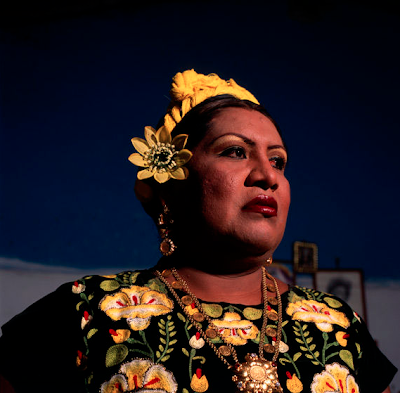Summer rerun: Ann Summa
I was watching my nightly fix of Anthony Bourdain, and on this particular episode, he was visiting French Polynesia. As part of the episode, he went to a nighclub filled with transvestites, but not any transvestites. They are men that are part of the third sex. “According to Francois Bauer, for centuries, traditional families in French Polynesia raised their eldest son as a woman, or Mahu, believing him to have divine qualities, and the best traits of both sexes. In the 1960′s, when the French began nuclear testing in Tahiti, there weren’t enough women to entertain all of the soldiers, so many of the local men became women.”
I found all of this quite fascinating and I remembered that I had written about a similar subject last year produced by photographer Ann Summa. I am rerunning the post here:
“There’s a legend in Mexico that says when God was flying over the country distributing homosexuals, he got tired over the state of Oaxaca and left most of them there.”
Los Angeles photographer, Ann Summa, explores a fascinating cultural phenomenon to create portraits of Muxes, men living as women, who are often the last male child and become the help-mate to aging parents.
Ann is an habitual world traveler. She studied photography in Japan, teaches photography at Otis College of Art and Design in Los Angeles, and lives part time in San Miguel de Allende, Mexico. Her commercial work specializes in environmental, corporate, and celebrity portraiture, but she finds time so shoot work as an advocate for women’s health issues. Her fine art work looks at fringe cultures, from punk rock to women who own pit bulls to facets of Mexican culture.
In Zapotec cultures of Oaxaca , a muxe is a physically Male individual who dresses and behaves in a feminine manner; they may be seen as a Third gender. Some marry women and have children while others choose men as sexual or romantic partners. According to anthropologist Lynn Stephen, muxe “may do certain kinds of women’s work such as embroidery or decorating home altars, but others do the male work of making Jewelry. Many now have white-collar jobs and are involved in politics.”
“We are the third sex. There’s men and women and there’s someone in between, and that’s who I am”
In Oaxaca, the rarely married muxes are often considered a family blessing, prized as family caretakers, and, along with widows, are considered acceptable partners when it comes to premarital sex for young Catholic boys. “Sleeping with a muxe does not make a man gay,” Summa says she’s been told. “It makes him feel more macho.”
Many indigenous Zapotec residents still honor Mayan dual-sex gods and cross-dressing Aztec priests, stands out among the others in mostly mestizo Catholic Mexico. Oaxaca has a matriarchal-based society; women are responsible for running most of the businesses here. As a result, most gay people find the state the most welcoming in the country. 
Posts on Lenscratch may not be reproduced without the permission of the Lenscratch staff and the photographer.
Recommended
-
Paccarik Orue: El MuquiDecember 9th, 2025
-
Lauri Gaffin: Moving Still: A Cinematic Life Frame-by-FrameDecember 4th, 2025
-
Dani Tranchesi: Ordinary MiraclesNovember 30th, 2025
-
Art of Documentary Photography: Elliot RossOctober 30th, 2025
-
The Art of Documentary Photography: Carol GuzyOctober 29th, 2025




































































